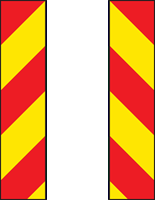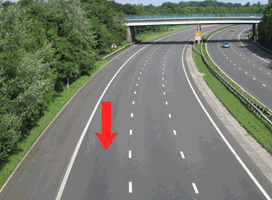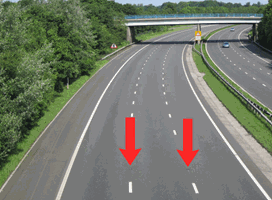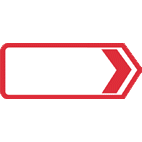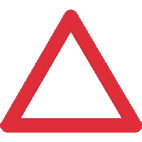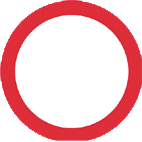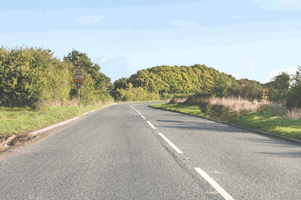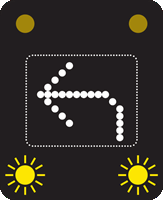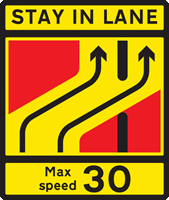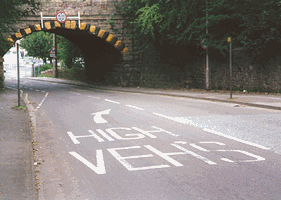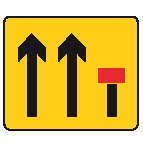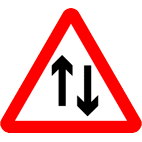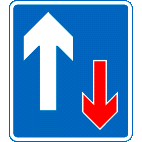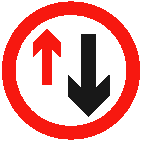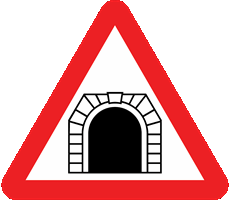You have 57 minutes to answer 50 multiple choice motorcycle theory test questions. You need to score at least 86% 43 out of 50 to pass the test. Answers may be checked after each question by clicking the 'check answer' button or you can wait until the end of the test to review your final score. Best of luck!
Motorcycle Theory Test Practice (2025)
Test Quick View
Click question box to reveal the correct answer. You can print these questions out by clicking the printer icon.
Correct Answer: D
Explanation: When you're carrying a passenger on a motorcycle, the overall weight will be much more than when you're riding alone. This additional weight will make it harder for you to stop quickly in an emergency, so you'll need to increase the distance between your motorcycle and the vehicle in front.
Explanation: When you're carrying a passenger on a motorcycle, the overall weight will be much more than when you're riding alone. This additional weight will make it harder for you to stop quickly in an emergency, so you'll need to increase the distance between your motorcycle and the vehicle in front.
Correct Answer: D
Explanation: Always plan ahead and be aware of lanes and areas designated for specific road users only. The restrictions are sometimes in force only at certain times of day, and signs will show when they apply. In some towns, motorcycles are permitted to use bus lanes - check the signs carefully.
Explanation: Always plan ahead and be aware of lanes and areas designated for specific road users only. The restrictions are sometimes in force only at certain times of day, and signs will show when they apply. In some towns, motorcycles are permitted to use bus lanes - check the signs carefully.
B
C
D
Correct Answer: B
Explanation: The handling of your motorcycle will be greatly affected by the road surface. Look well ahead and be especially alert if the road looks uneven or has loose chippings. Slow down in good time, as braking harshly in these conditions will cause you to skid. For the same reason, avoid making sudden changes of direction.
Explanation: The handling of your motorcycle will be greatly affected by the road surface. Look well ahead and be especially alert if the road looks uneven or has loose chippings. Slow down in good time, as braking harshly in these conditions will cause you to skid. For the same reason, avoid making sudden changes of direction.
Correct Answer: C
Explanation: When riding, look ahead and around you. Don't look down at the front wheel, as this can severely upset your balance.
Explanation: When riding, look ahead and around you. Don't look down at the front wheel, as this can severely upset your balance.
Correct Answer: D
Explanation: After refitting the rear wheel or adjusting the drive chain, you should check your wheel alignment. Incorrect alignment will result in excessive tyre wear and poor roadholding.
Explanation: After refitting the rear wheel or adjusting the drive chain, you should check your wheel alignment. Incorrect alignment will result in excessive tyre wear and poor roadholding.
B
C
D
Correct Answer: D
Explanation: You'll need to adapt your riding technique when riding a motorcycle fitted with a sidecar. The extra weight will affect the handling and may increase your overall stopping distance.
Explanation: You'll need to adapt your riding technique when riding a motorcycle fitted with a sidecar. The extra weight will affect the handling and may increase your overall stopping distance.
Correct Answer: C
Explanation: If you're involved in a collision, using the engine cut-out switch will help to reduce the risk of fire. When stopping the engine normally, use the ignition switch.
Explanation: If you're involved in a collision, using the engine cut-out switch will help to reduce the risk of fire. When stopping the engine normally, use the ignition switch.
8. You're riding a motorcycle that has an engine of less than 50 cc. What should you do if you see a queue of traffic building up behind?
Mark one answer
B
C
D
Correct Answer: C
Explanation: Try not to hold up a queue of traffic. This might lead to other road users becoming impatient and attempting dangerous manoeuvres. If you're riding a slow-moving scooter or small motorcycle and a queue of traffic has built up behind you, look for a safe place to pull in so they can pass safely.
Explanation: Try not to hold up a queue of traffic. This might lead to other road users becoming impatient and attempting dangerous manoeuvres. If you're riding a slow-moving scooter or small motorcycle and a queue of traffic has built up behind you, look for a safe place to pull in so they can pass safely.
B
C
D
Correct Answer: D
Explanation: Only use the engine cut-out switch in an emergency. When stopping the engine normally, use the ignition switch. This will remind you to take your keys with you when parking. It could also prevent starting problems if you forget you've left the cut-out switch in the 'off' position.
Explanation: Only use the engine cut-out switch in an emergency. When stopping the engine normally, use the ignition switch. This will remind you to take your keys with you when parking. It could also prevent starting problems if you forget you've left the cut-out switch in the 'off' position.
Correct Answer: B
Explanation: The smooth steel surface can be slippery and dangerous for motorcyclists, especially when it's wet. Try to cross tram lines at right angles.
Explanation: The smooth steel surface can be slippery and dangerous for motorcyclists, especially when it's wet. Try to cross tram lines at right angles.
B
C
D
Correct Answer: C
Explanation: If fuel, especially diesel, is spilt on the road, it will make the surface very slippery. In wet weather, it can be seen as a rainbow-coloured pattern on the road.
Explanation: If fuel, especially diesel, is spilt on the road, it will make the surface very slippery. In wet weather, it can be seen as a rainbow-coloured pattern on the road.
Correct Answer: A
Explanation: Learner motorcyclists aren't allowed to
Explanation: Learner motorcyclists aren't allowed to
- tow a trailer
- carry a pillion passenger
- use the motorway.
13. Your motorcycle doesn't have linked brakes. What should you do when braking normally to a stop?
Mark one answer
B
C
D
Correct Answer: A
Explanation: In normal riding, you should always use both brakes. Braking when the motorcycle is upright and travelling in a straight line helps you to keep control. If your motorcycle has linked brakes, refer to the vehicle handbook.
Explanation: In normal riding, you should always use both brakes. Braking when the motorcycle is upright and travelling in a straight line helps you to keep control. If your motorcycle has linked brakes, refer to the vehicle handbook.
14. It's been raining after a long dry spell. How will this affect the road surface?
Mark one answer
B
C
D
Correct Answer: C
Explanation: During a long spell of hot, dry weather, the road surface will become coated with rubber and dust. When it rains after this, the road surface will be unusually slippery. Take extra care, particularly at junctions, bends and roundabouts, and allow double the usual stopping distance.
Explanation: During a long spell of hot, dry weather, the road surface will become coated with rubber and dust. When it rains after this, the road surface will be unusually slippery. Take extra care, particularly at junctions, bends and roundabouts, and allow double the usual stopping distance.
Correct Answer: C
Explanation: Young and inexperienced motorcyclists often have more confidence than ability. It takes time to gain experience and become a good rider. Make sure you have the right attitude and put safety first.
Explanation: Young and inexperienced motorcyclists often have more confidence than ability. It takes time to gain experience and become a good rider. Make sure you have the right attitude and put safety first.
Correct Answer: D
Explanation: These signs apply only to tram drivers, but you should know their meaning so that you're aware of the priorities and are able to anticipate the actions of the driver.
Explanation: These signs apply only to tram drivers, but you should know their meaning so that you're aware of the priorities and are able to anticipate the actions of the driver.
Correct Answer: B
Explanation: These markers must be fitted to vehicles over 13 metres long, large goods vehicles, and rubbish skips placed in the road. They're reflective to make them easier to see in the dark.
Explanation: These markers must be fitted to vehicles over 13 metres long, large goods vehicles, and rubbish skips placed in the road. They're reflective to make them easier to see in the dark.
18. Which type of vehicle should you be ready to give way to as you approach this bridge?
Mark one answer
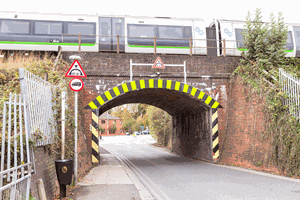
B
C
D
Correct Answer: B
Explanation: A double-deck bus or high-sided lorry will have to take a position in the centre of the road to clear the bridge. There's normally a sign to show this. Look well ahead, past the bridge and be ready to stop and give way to large oncoming vehicles.
Explanation: A double-deck bus or high-sided lorry will have to take a position in the centre of the road to clear the bridge. There's normally a sign to show this. Look well ahead, past the bridge and be ready to stop and give way to large oncoming vehicles.
Correct Answer: D
Explanation: Be tolerant of older drivers. They may take longer to react to a hazard and they may be hesitant in some situations - for example, at a junction.
Explanation: Be tolerant of older drivers. They may take longer to react to a hazard and they may be hesitant in some situations - for example, at a junction.
Correct Answer: A
Explanation: On a motorway, all traffic should use the left-hand lane unless overtaking. When overtaking a number of slower vehicles, move back to the left-hand lane when you're safely past. Check your mirrors frequently and don't stay in the middle or right-hand lane if the left-hand lane is free.
Explanation: On a motorway, all traffic should use the left-hand lane unless overtaking. When overtaking a number of slower vehicles, move back to the left-hand lane when you're safely past. Check your mirrors frequently and don't stay in the middle or right-hand lane if the left-hand lane is free.
Correct Answer: C
Explanation: On motorways, reflective studs of various colours are fixed in the road between the lanes. These help you to identify which lane you're in when it's dark or in poor visibility. Amber-coloured studs are found on the right-hand edge of the main carriageway, next to the central reservation.
Explanation: On motorways, reflective studs of various colours are fixed in the road between the lanes. These help you to identify which lane you're in when it's dark or in poor visibility. Amber-coloured studs are found on the right-hand edge of the main carriageway, next to the central reservation.
Correct Answer: D
Explanation: White studs are found between the lanes on motorways. They reflect back the light from your headlights. This is especially useful in bad weather, when visibility is restricted.
Explanation: White studs are found between the lanes on motorways. They reflect back the light from your headlights. This is especially useful in bad weather, when visibility is restricted.
23. There's a tractor ahead. You want to overtake but you aren't sure whether it's safe. What should you do?
Mark one answer
B
C
D
Correct Answer: D
Explanation: Following a tractor can be frustrating, but never overtake if you're unsure whether it's safe. Ask yourself: 'Can I see far enough down the road to ensure that I can complete the manoeuvre safely?' It's better to be delayed for a minute or two than to take a chance that may cause a collision.
Explanation: Following a tractor can be frustrating, but never overtake if you're unsure whether it's safe. Ask yourself: 'Can I see far enough down the road to ensure that I can complete the manoeuvre safely?' It's better to be delayed for a minute or two than to take a chance that may cause a collision.
24. You're approaching a busy junction. What should you do when, at the last moment, you realise you're in the wrong lane?
Mark one answer
B
C
D
Correct Answer: A
Explanation: There are times when road markings are obscured by queuing traffic, or you're unsure which lane to use. If, at the last moment, you find you're in the wrong lane, don't cut across or bully other drivers to let you in. Follow the lane you're in and find somewhere safe to turn around and rejoin your route.
Explanation: There are times when road markings are obscured by queuing traffic, or you're unsure which lane to use. If, at the last moment, you find you're in the wrong lane, don't cut across or bully other drivers to let you in. Follow the lane you're in and find somewhere safe to turn around and rejoin your route.
Correct Answer: D
Explanation: Road signs in the shape of a circle give orders. Those with a red circle are mostly prohibitive. The 'stop' sign is octagonal to give it greater prominence. Signs giving orders must always be obeyed.
Explanation: Road signs in the shape of a circle give orders. Those with a red circle are mostly prohibitive. The 'stop' sign is octagonal to give it greater prominence. Signs giving orders must always be obeyed.
Correct Answer: C
Explanation: Some crossings have gates but no attendant or signals. You should stop, look both ways, listen and make sure that no train is approaching. If there's a telephone, contact the signal operator to make sure it's safe to cross.
Explanation: Some crossings have gates but no attendant or signals. You should stop, look both ways, listen and make sure that no train is approaching. If there's a telephone, contact the signal operator to make sure it's safe to cross.
Correct Answer: D
Explanation: Road markings will warn you of a hazard ahead. A single broken line along the centre of the road, with long markings and short gaps, is a hazard warning line. Don't cross it unless you can see that the road is clear well ahead.
Explanation: Road markings will warn you of a hazard ahead. A single broken line along the centre of the road, with long markings and short gaps, is a hazard warning line. Don't cross it unless you can see that the road is clear well ahead.
Correct Answer: B
Explanation: You'll see this sign if the motorway is closed ahead. Pull into the left-hand lane as soon as it's safe to do so. Don't wait until the last moment before you move across, because the lane may be busy and you'll have to rely on another driver making room for you.
Explanation: You'll see this sign if the motorway is closed ahead. Pull into the left-hand lane as soon as it's safe to do so. Don't wait until the last moment before you move across, because the lane may be busy and you'll have to rely on another driver making room for you.
29. You see a car on the hard shoulder of a motorway with a 'help' pennant displayed. What does this mean?
Mark one answer
B
C
D
Correct Answer: D
Explanation: If a disabled driver's vehicle breaks down and they're unable to walk to an emergency phone, they're advised to stay in their car and switch on the hazard warning lights. They may also display a 'help' pennant in their vehicle.
Explanation: If a disabled driver's vehicle breaks down and they're unable to walk to an emergency phone, they're advised to stay in their car and switch on the hazard warning lights. They may also display a 'help' pennant in their vehicle.
Correct Answer: A
Explanation: Learners might not have confidence when they first start to drive. Allow them plenty of room and don't react adversely to their hesitation. We all learn from experience, but new drivers will have had less practice in dealing with all the situations that might occur.
Explanation: Learners might not have confidence when they first start to drive. Allow them plenty of room and don't react adversely to their hesitation. We all learn from experience, but new drivers will have had less practice in dealing with all the situations that might occur.
31. You're on a motorway. A lorry has stopped in the right-hand lane. What should you do when you see this sign on the lorry?
Mark one answer
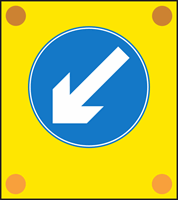
B
C
D
Correct Answer: C
Explanation: Sometimes work is carried out on the motorway without closing the lanes. When this happens, signs are mounted on the back of lorries to warn other road users of the roadworks ahead.
Explanation: Sometimes work is carried out on the motorway without closing the lanes. When this happens, signs are mounted on the back of lorries to warn other road users of the roadworks ahead.
Correct Answer: D
Explanation: If you're planning to make a journey when it's foggy, listen to the weather reports. If visibility is very poor, avoid making unnecessary journeys. If you do travel, leave plenty of time - and if someone is waiting for you to arrive, let them know that your journey will take longer than normal. This will also take off any pressure you may feel to rush.
Explanation: If you're planning to make a journey when it's foggy, listen to the weather reports. If visibility is very poor, avoid making unnecessary journeys. If you do travel, leave plenty of time - and if someone is waiting for you to arrive, let them know that your journey will take longer than normal. This will also take off any pressure you may feel to rush.
Correct Answer: B
Explanation: At roadworks, and especially where a contraflow system is operating, a speed restriction is likely to be in place. Keep to the lower speed limit and don't
Explanation: At roadworks, and especially where a contraflow system is operating, a speed restriction is likely to be in place. Keep to the lower speed limit and don't
- switch lanes
- get too close to the vehicle in front of you.
Correct Answer: D
Explanation: Never sound the horn aggressively. You mustn't sound it when driving in a built-up area between 11.30 pm and 7.00 am, or when you're stationary, unless another road user poses a danger. Don't scare animals by sounding your horn.
Explanation: Never sound the horn aggressively. You mustn't sound it when driving in a built-up area between 11.30 pm and 7.00 am, or when you're stationary, unless another road user poses a danger. Don't scare animals by sounding your horn.
Correct Answer: A
Explanation: Oncoming large vehicles may need to move to the middle of the road to pass safely under the bridge. There won't be enough room for you to continue, so you should be ready to stop and wait.
Explanation: Oncoming large vehicles may need to move to the middle of the road to pass safely under the bridge. There won't be enough room for you to continue, so you should be ready to stop and wait.
Correct Answer: C
Explanation: Even though you have priority, be prepared to give way if other drivers don't. This will help to avoid congestion, confrontation or even a collision.
Explanation: Even though you have priority, be prepared to give way if other drivers don't. This will help to avoid congestion, confrontation or even a collision.
Correct Answer: A
Explanation: When parking at night, park in the direction of the traffic. This will enable other road users to see the reflectors on the rear of your vehicle. Use your parking lights if the speed limit is over 30 mph.
Explanation: When parking at night, park in the direction of the traffic. This will enable other road users to see the reflectors on the rear of your vehicle. Use your parking lights if the speed limit is over 30 mph.
Correct Answer: A
Explanation: If you see that parts of the tread on your tyres are wearing before others, it may indicate a brake, steering or suspension fault. Regular servicing will help to detect faults at an early stage and this will avoid the risk of minor faults becoming serious or even dangerous.
Explanation: If you see that parts of the tread on your tyres are wearing before others, it may indicate a brake, steering or suspension fault. Regular servicing will help to detect faults at an early stage and this will avoid the risk of minor faults becoming serious or even dangerous.
Correct Answer: A
Explanation: In some built-up areas, you may find the speed limit reduced to 20 mph. Driving at a slower speed will help give you the time and space to see and deal safely with hazards such as pedestrians and other vulnerable road users.
Explanation: In some built-up areas, you may find the speed limit reduced to 20 mph. Driving at a slower speed will help give you the time and space to see and deal safely with hazards such as pedestrians and other vulnerable road users.
Correct Answer: D
Explanation: Note that this is the typical stopping distance. It will take at least this distance to think, brake and stop in good conditions. In poor conditions, it will take much longer.
Explanation: Note that this is the typical stopping distance. It will take at least this distance to think, brake and stop in good conditions. In poor conditions, it will take much longer.
Correct Answer: C
Explanation: This distance is the equivalent of 18 car lengths. Try pacing out 73 metres and then look back. It's probably further than you think.
Explanation: This distance is the equivalent of 18 car lengths. Try pacing out 73 metres and then look back. It's probably further than you think.
42. A driver's behaviour has upset you. What can you do to safely get over this incident?
Mark one answer
B
C
D
Correct Answer: D
Explanation: If you feel yourself becoming tense or upset, stop in a safe place and take a break. Tiredness can make things worse and may cause a different reaction to upsetting situations.
Explanation: If you feel yourself becoming tense or upset, stop in a safe place and take a break. Tiredness can make things worse and may cause a different reaction to upsetting situations.
Correct Answer: C
Explanation: When you're following a long vehicle, stay well back so that you can get a better view of the road ahead. The closer you get, the less you'll be able to see of the road. Be patient and don't take a gamble. Only overtake when you're certain that you can complete the manoeuvre safely.
Explanation: When you're following a long vehicle, stay well back so that you can get a better view of the road ahead. The closer you get, the less you'll be able to see of the road. Be patient and don't take a gamble. Only overtake when you're certain that you can complete the manoeuvre safely.
Correct Answer: B
Explanation: You'll see this sign if there has been an incident ahead and the motorway is closed. You must obey the sign. Make sure that you prepare to leave in good time. Don't cause drivers to take avoiding action by cutting in at the last moment.
Explanation: You'll see this sign if there has been an incident ahead and the motorway is closed. You must obey the sign. Make sure that you prepare to leave in good time. Don't cause drivers to take avoiding action by cutting in at the last moment.
Correct Answer: C
Explanation: You shouldn't normally stop on a motorway, but there may be occasions when you need to do so. If you're unfortunate enough to break down, make every effort to pull up on the hard shoulder.
Explanation: You shouldn't normally stop on a motorway, but there may be occasions when you need to do so. If you're unfortunate enough to break down, make every effort to pull up on the hard shoulder.
46. You're approaching this roundabout and see the cyclist signal right. Why is the cyclist keeping to the left?
Mark one answer
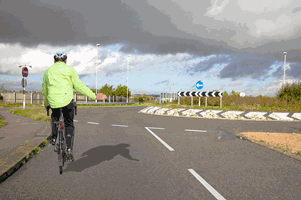
B
C
D
Correct Answer: C
Explanation: Cycling in today's heavy traffic can be hazardous. Some cyclists may not feel happy about crossing the path of traffic to take up a position in an outside lane. Be aware of this and understand that, although they're in the left-hand lane, the cyclist might be turning right.
Explanation: Cycling in today's heavy traffic can be hazardous. Some cyclists may not feel happy about crossing the path of traffic to take up a position in an outside lane. Be aware of this and understand that, although they're in the left-hand lane, the cyclist might be turning right.
47. A casualty isn't breathing normally. Chest compressions should be given. At what rate?
Mark one answer
B
C
D
Correct Answer: B
Explanation: If a casualty isn't breathing normally, chest compressions may be needed to maintain circulation. Place two hands on the centre of the chest and press down hard and fast - around 5-6 centimetres and about twice a second.
Explanation: If a casualty isn't breathing normally, chest compressions may be needed to maintain circulation. Place two hands on the centre of the chest and press down hard and fast - around 5-6 centimetres and about twice a second.
48. A police officer asks to see your documents. You don't have them with you. Within what time must you produce them at a police station?
Mark one answer
B
C
D
Correct Answer: D
Explanation: You don't have to carry around your vehicle's documents wherever you go. If a police officer asks to see them and you don't have them with you, you may be asked to produce them at a police station within 7 days.
Explanation: You don't have to carry around your vehicle's documents wherever you go. If a police officer asks to see them and you don't have them with you, you may be asked to produce them at a police station within 7 days.
Correct Answer: D
Explanation: When approaching a tunnel, switch on your dipped headlights. Be aware that your eyes might need to adjust to the sudden darkness. You may need to reduce your speed.
Explanation: When approaching a tunnel, switch on your dipped headlights. Be aware that your eyes might need to adjust to the sudden darkness. You may need to reduce your speed.
B
C
D
Correct Answer: D
Explanation: If there's nothing in the wound, applying a pad of clean cloth or bandage will help stem the bleeding. Raising the leg will also lessen the flow of blood. Don't tie anything tightly round the leg, as this will restrict circulation and could result in long-term injury.
Explanation: If there's nothing in the wound, applying a pad of clean cloth or bandage will help stem the bleeding. Raising the leg will also lessen the flow of blood. Don't tie anything tightly round the leg, as this will restrict circulation and could result in long-term injury.


